An Evaluation of the Robustness of Length-Based Stock Assessment Approaches for Sustainable Fisheries Management in Data and Capacity Limited Situations
Abstract
1. Introduction
2. Materials and Methods
2.1. Simulation Framework
2.1.1. Operating Model Conditioning
2.1.2. Life Histories
2.1.3. Fishery Dynamics
2.2. Observation Error Model
2.3. Length-Based Approaches
2.3.1. Indicators
2.3.2. Beverton and Holt Estimator
2.3.3. Length-Converted Catch Curve (LCC)
2.3.4. Length-Based SPR (LBSPR)
2.3.5. Length-Based Integrated Mixed Effects (LIME)
Proxy Reference Points
Baselines
3. Results
4. Discussion
5. Conclusions
Author Contributions
Funding
Institutional Review Board Statement
Informed Consent Statement
Data Availability Statement
Conflicts of Interest
Abbreviations
| EAF | Ecosystem Approach to Fisheries |
| ETP | Endangered, Threatened or Protected |
| MSC | Marine Stewardship Council |
| MSE | Management Strategy Evaluation |
| OM | Operating Model |
| OEM | Observation Error Mode |
| MP | Management Procedure |
| HCR | Harvest Control Rule |
| FLR | Fisheries Library in R |
| SSB | Spawning Stock Biomass |
| SRP | Spawner-Recruit Potential |
| MSY | Maximum Sustainable Yield |
| BMSY | Biomass at Maximum Sustainable Yield |
| FMSY | Fishing mortality at Maximum Sustainable Yield |
| Lmean | Mean length of individuals above a threshold |
| Lc | Length at first capture |
| Lc50 | Length at 50% capture probability |
| LF=M | Length at which fishing mortality equals natural mortality |
| Lopt | Length at which cohort biomass is maximized |
| Lm | Length at maturity |
| L50 | Length at 50% maturity |
| L95 | Length at 95% maturity |
| S50 | Size at 50% selectivity |
| S95 | Size at 95% selectivity |
| CV | Coefficient of Variation |
| CVL | Coefficient of Variation in Length |
| BH | Beverton and Holt estimator |
| LCC | Length-converted Catch Curve |
| LBSPR | Length-Based Spawning Potential Ratio |
| LIME | Length-based Integrated Mixed Effects |
| SPR | Spawning Potential Ratio |
| ROC | Receiver Operating Characteristic |
| TP | True Positive |
| FP | False Positive |
| TN | True Negative |
| FN | False Negative |
| TPR | True Positive Rate (Sensitivity) |
| TNR | True Negative Rate (Specificity) |
| FPR | False Positive Rate |
| AUC | Area Under the Curve |
| BSS | Best-Skill Score |
| TSS | True Skill Statistic |
Appendix A. Simulation Framework
Appendix B. Operating Model
Appendix B.1. Scenarios
Appendix B.2. Conditioning
Appendix B.2.1. Life History Processes
Individual Growth
Maturity-at-Age
Natural Mortality
Selection Pattern
Stock Recruitment Relationship
Appendix B.2.2. Equilibrium Analysis
Appendix B.2.3. Projection
References
- Garcia, S.M. The Ecosystem Approach to Fisheries: Issues, Terminology, Principles, Institutional Foundations, Implementation and Outlook; FAO: Roma, Italy, 2003; Volume 443. [Google Scholar]
- Fulton, B.; Sainsbury, K. Foodweb Structure, the Hub Index and Identifying Species of Ecological Significance. Ecol. Indic. 2024, 166, 112378. [Google Scholar] [CrossRef]
- Council, M.S. MSC Fisheries Standard Version 2.01; MSC: London, UK, 2018. [Google Scholar]
- Cirtwill, A.R.; Dalla Riva, G.V.; Gaiarsa, M.P.; Bimler, M.D.; Cagua, E.F.; Coux, C.; Dehling, D.M. A review of species role concepts in food webs. Food Webs 2018, 16, e00093. [Google Scholar] [CrossRef]
- Roa-Ureta, R.H.; Amorim, P.; Segurado, S. Probability ogives for trends in stock biomass and fishing mortality from landings time series. Fish Fish. 2024, 25, 823–836. [Google Scholar] [CrossRef]
- Ovando, D.; Free, C.M.; Jensen, O.P.; Hilborn, R. A history and evaluation of catch-only stock assessment models. Fish Fish. 2022, 23, 616–630. [Google Scholar] [CrossRef]
- Kell, L.T.; Sharma, R.; Kitakado, T.; Winker, H.; Mosqueira, I.; Cardinale, M.; Fu, D. Validation of stock assessment methods: Is it me or my model talking? ICES J. Mar. Sci. 2021, 78, 2244–2255. [Google Scholar] [CrossRef]
- Vasilakopoulos, P.; O’Neill, F.G.; Marshall, C.T. The unfulfilled potential of fisheries selectivity to promote sustainability. Fish Fish. 2016, 17, 399–416. [Google Scholar] [CrossRef]
- Griffiths, C.A.; Winker, H.; Bartolino, V.; Wennhage, H.; Orio, A.; Cardinale, M. Including older fish in fisheries management: A new age-based indicator and reference point for exploited fish stocks. Fish Fish. 2024, 25, 18–37. [Google Scholar] [CrossRef]
- Beverton, R.J.H.; Holt, S.J. Review of method for estimating mortality rates in exploited fish populations, with special reference to sources of bias in catch sampling. Rapp. Proces-Verbaux 1956, 140, 67–83. [Google Scholar]
- Pauly, D.; Morgan, G.R. Length-Based Methods in Fisheries Research; WorldFish: Penang, Malaysia, 1987; Volume 13. [Google Scholar]
- Kell, L.T.; Minto, C.; Gerritsen, H.D. Evaluation of the skill of length-based indicators to identify stock status and trends. ICES J. Mar. Sci. 2022, 79, 1202–1216. [Google Scholar] [CrossRef]
- Little, L.R.; Wayte, S.E.; Tuck, G.N.; Smith, A.D.; Klaer, N.; Haddon, M.; Punt, A.E.; Thomson, R.; Day, J.; Fuller, M. Development and evaluation of a cpue-based harvest control rule for the southern and eastern scalefish and shark fishery of Australia. ICES J. Mar. Sci. 2011, 68, 1699–1705. [Google Scholar] [CrossRef]
- Saltelli, A.; Bammer, G.; Bruno, I.; Charters, E.; Di Fiore, M.; Didier, E.; Nelson Espeland, W.; Kay, J.; Lo Piano, S.; Mayo, D.; et al. Five ways to ensure that models serve society: A manifesto. Nature 2020, 582, 482–484. [Google Scholar] [CrossRef] [PubMed]
- Hodges, J.S.; Dewar, J.A.; Center, A. Is It You or Your Model Talking?: A Framework for Model Validation; Rand: Santa Monica, CA, USA, 1992. [Google Scholar]
- Miethe, T.; Reecht, Y.; Dobby, H. Reference points for the length-based indicator Lmax5 for use in the assessment of data-limited stocks. ICES J. Mar. Sci. 2019, 76, 2125–2139. [Google Scholar] [CrossRef]
- United Nations. System of Environmental-Economic Accounting 2012; United Nations: New York, NY, USA, 2012. [Google Scholar]
- Roberts, L.; Stone, R.; Sugden, A. The rise of restoration ecology. Science 2009, 325, 555. [Google Scholar] [CrossRef]
- Humphries, F.; Harden-Davies, H. Practical policy solutions for the final stage of BBNJ treaty negotiations. Mar. Policy 2020, 122, 104214. [Google Scholar] [CrossRef]
- Pons, M.; Cope, J.M.; Kell, L.T. Comparing performance of catch-based and length-based stock assessment methods in data-limited fisheries. Can. J. Fish. Aquat. Sci. 2020, 77, 1026–1037. [Google Scholar] [CrossRef]
- Rudd, M.B.; Thorson, J.T. Accounting for variable recruitment and fishing mortality in length-based stock assessments for data-limited fisheries. Can. J. Fish. Aquat. Sci. 2017, 75, 1019–1035. [Google Scholar] [CrossRef]
- Hordyk, A.R.; Loneragan, N.R.; Prince, J.D. An evaluation of an iterative harvest strategy for data-poor fisheries using the length-based spawning potential ratio assessment methodology. Fish. Res. 2015, 171, 20–32. [Google Scholar] [CrossRef]
- McGranaghan, R.M.; Mannucci, A.J.; Wilson, B.; Mattmann, C.A.; Chadwick, R. New capabilities for prediction of high-latitude ionospheric scintillation: A novel approach with machine learning. Space Weather 2018, 16, 1817–1846. [Google Scholar] [CrossRef]
- Bloomfield, D.S.; Higgins, P.A.; McAteer, R.J.; Gallagher, P.T. Toward reliable benchmarking of solar flare forecasting methods. Astrophys. J. Lett. 2012, 747, L41. [Google Scholar] [CrossRef]
- Kell, L.; Mosqueira, I.; Grosjean, P.; Fromentin, J.; Garcia, D.; Hillary, R.; Jardim, E.; Mardle, S.; Pastoors, M.; Poos, J.; et al. FLR: An open-source framework for the evaluation and development of management strategies. ICES J. Mar. Sci. 2007, 64, 640. [Google Scholar] [CrossRef]
- Rademeyer, R.A.; Plagányi, É.E.; Butterworth, D.S. Tips and tricks in designing management procedures. ICES J. Mar. Sci. 2007, 64, 618–625. [Google Scholar] [CrossRef]
- Gislason, H.; Daan, N.; Rice, J.; Pope, J. Does Natural Mortality Depend on Individual Size. In Proceedings of the ICES Annual Science Conference, Halifax, NS, Canada, 22–26 September 2008. [Google Scholar]
- Trippel, E. Estimation of stock reproductive potential: History and challenges for Canadian Atlantic gadoid stock assessments. J. Northwest Atl. Fish. Sci. 1999, 25, 61–82. [Google Scholar] [CrossRef]
- Murawski, S.; Rago, P.; Trippel, E. Impacts of demographic variation in spawning characteristics on reference points for fishery management. ICES J. Mar. Sci. 2001, 58, 1002–1014. [Google Scholar] [CrossRef]
- Matsuda, H.; Fukase, K.; Kotaki, K.; Asano, K. Inconsistency between the per capita fecundity and estimate of the yearly egg production of the chub mackerel Scomber japonicus in Japan. Fish. Sci. 1996, 62, 178–183. [Google Scholar] [CrossRef]
- Lee, H.; Maunder, M.N.; Piner, K.R. Good Practices for estimating and using length-at-age in integrated stock assessments. Fish. Res. 2024, 270, 106883. [Google Scholar] [CrossRef]
- Von Bertalanffy, L. Quantitative laws in metabolism and growth. Q. Rev. Biol. 1957, 32, 217–231. [Google Scholar] [CrossRef]
- Pauly, D. Fish Population Dynamics in Tropical Waters: A Manual for Use with Programmable Calculators; International Center for Living Aquatic Resources Management (ICLARM): Makati, Philippines, 1984; p. 325. [Google Scholar]
- Hordyk, A.; Ono, K.; Valencia, S.; Loneragan, N.; Prince, J. A novel length-based empirical estimation method of spawning potential ratio (SPR), and tests of its performance, for small-scale, data-poor fisheries. ICES J. Mar. Sci. 2014, 72, 217–231. [Google Scholar] [CrossRef]
- Haddon, M.; Dichmont, C.; Klaer, N.; Pascoe, S.; Penney, A.; Smith, A.; Ward, P. Technical Reviews of Formal Harvest Strategies; Report; Australian Fisheries Management Authority: Canberra, Australia, 2012.
- Froese, R. Keep it simple: Three indicators to deal with overfishing. Fish Fish. 2004, 5, 86–91. [Google Scholar] [CrossRef]
- Lee, H.H.; Maunder, M.N.; Piner, K.R.; Methot, R.D. Estimating natural mortality within a fisheries stock assessment model: An evaluation using simulation analysis based on twelve stock assessments. Fish. Res. 2011, 109, 89–94. [Google Scholar] [CrossRef]
- Froese, R.; Pauly, D. Taking stock of global fisheries. Science 2024, 385, 824–825. [Google Scholar] [CrossRef]
- Froese, R.; Winker, H.; Coro, G.; Palomares, M.L.; Tsikliras, A.C.; Dimarchopoulou, D.; Touloumis, K.; Demirel, N.; Vianna, G.; Scarcella, G.; et al. New developments in the analysis of catch time series as the basis for fish stock assessments: The CMSY++ method. Acta Ichthyol. Piscat. 2023, 53, 173–189. [Google Scholar] [CrossRef]
- Fischer, S.H.; De Oliveira, J.A.A.; Mumford, J.D.; Kell, L.T. Exploring a relative harvest rate strategy for moderately data-limited fisheries management. ICES J. Mar. Sci. 2022, 79, 1730–1741. [Google Scholar] [CrossRef]
- Pomarede, M.; Hillary, R.; Ibaibarriaga, L.; Bogaards, J.; Apostolaki, P. Evaluating the performance of survey-based operational management procedures. Aquat. Living Resour. 2010, 22, 219–232. [Google Scholar] [CrossRef][Green Version]
- O’Dwyer, A. Handbook of PI and PID Controller Tuning Rules; Imperial College Press: London, UK, 2003. [Google Scholar]
- Goethel, D.R.; Lucey, S.M.; Berger, A.M.; Gaichas, S.K.; Karp, M.A.; Lynch, P.D.; Walter, J.F., III. Recent advances in management strategy evaluation: Introduction to the special issue “Under pressure: Addressing fisheries challenges with Management Strategy Evaluation”. Can. J. Fish. Aquat. Sci. 2019, 76, 1689–1696. [Google Scholar] [CrossRef]
- Lee, H.H.; Maunder, M.N.; Piner, K.R.; Methot, R.D. Can steepness of the stock–recruitment relationship be estimated in fishery stock assessment models? Fish. Res. 2012, 125, 254–261. [Google Scholar] [CrossRef]
- Barlow, R.E.; Bartholomew, D.J., Jr.; Bremner, J.M.; Brunk, H.D. Statistical Inference under Order Restrictions: The Theory and Application of Isotonic Regression, 7th ed.; Wiley: London, UK, 1972. [Google Scholar]
- Mangel, M.; MacCall, A.D.; Brodziak, J.; Dick, E.; Forrest, R.E.; Pourzand, R.; Ralston, S. A perspective on steepness, reference points, and stock assessment. Can. J. Fish. Aquat. Sci. 2013, 70, 930–940. [Google Scholar] [CrossRef]
- Punt, A.E.; Butterworth, D.S.; de Moor, C.L.; De Oliveira, J.A.; Haddon, M. Management strategy evaluation: Best practices. Fish Fish. 2016, 17, 303–334. [Google Scholar] [CrossRef]
- Hamel, O.S. A method for calculating a meta-analytical prior for the natural mortality rate using multiple life history correlates. ICES J. Mar. Sci. 2014, 72, 62–69. [Google Scholar] [CrossRef]
- Walker, W.E.; Harremoës, P.; Rotmans, J.; van der Sluijs, J.P.; van Asselt, M.B.; Janssen, P.; Krayer von Krauss, M.P. Defining uncertainty: A conceptual basis for uncertainty management in model-based decision support. Integr. Assess. 2003, 4, 5–17. [Google Scholar] [CrossRef]
- Berger, A.; Pilling, G.; Kirchner, C.; Harley, S. Proposed F-Based Limit Reference Points for Bigeye, Yellowfin and South Pacific Albacore Tuna. In Proceedings of the 9th Regular Session of the Scientific Committee, Pohnpei, Micronesia, 6–14 August 2013. [Google Scholar]
- Beverton, R.; Holt, S. On the Dynamics of Exploited Fish Populations; Springer: Berlin/Heidelberg, Germany, 1993; Volume 11. [Google Scholar]
- Sissenwine, M.; Shepherd, J. An alternative perspective on recruitment overfishing and biological reference points. Can. J. Fish. Aquat. Sci. 1987, 44, 913–918. [Google Scholar] [CrossRef]
- Lorenzen, K.; Enberg, K. Density-dependent growth as a key mechanism in the regulation of fish populations: Evidence from among-population comparisons. Proc. R. Soc. Lond. Ser. B Biol. Sci. 2002, 269, 49–54. [Google Scholar] [CrossRef] [PubMed]
- Griffiths, D.; Harrod, C. Natural mortality, growth parameters, and environmental temperature in fishes revisited. Can. J. Fish. Aquat. Sci. 2007, 64, 249–255. [Google Scholar] [CrossRef]
- Pepin, P.; Marshall, C.T. Reconsidering the impossible—Linking environmental drivers to growth, mortality, and recruitment of fish 1. Can. J. Fish. Aquat. Sci. 2015, 72, 1–11. [Google Scholar] [CrossRef]
- Gabriel, W.; Mace, P. A review of biological reference points in the context of the precautionary approach. In Proceedings of the Fifth National NMFS Stock Assessment Workshop: Providing Scientific Advice to Implement the Precautionary Approach Under the Magnuson-Stevens Fishery Conservation and Management Act, Key Largo, FL, USA, 24–26 February 1998; pp. 34–45. [Google Scholar]
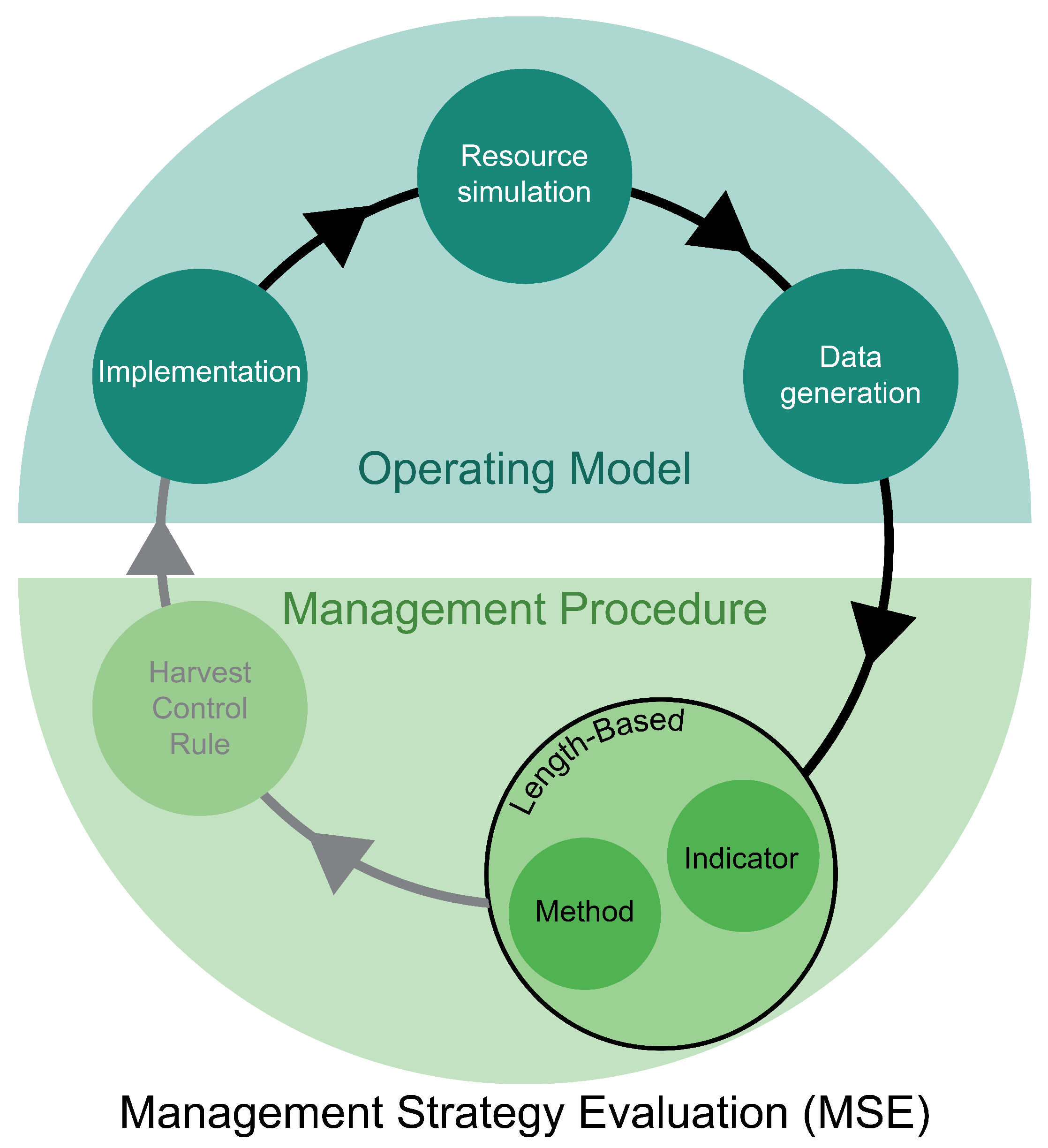
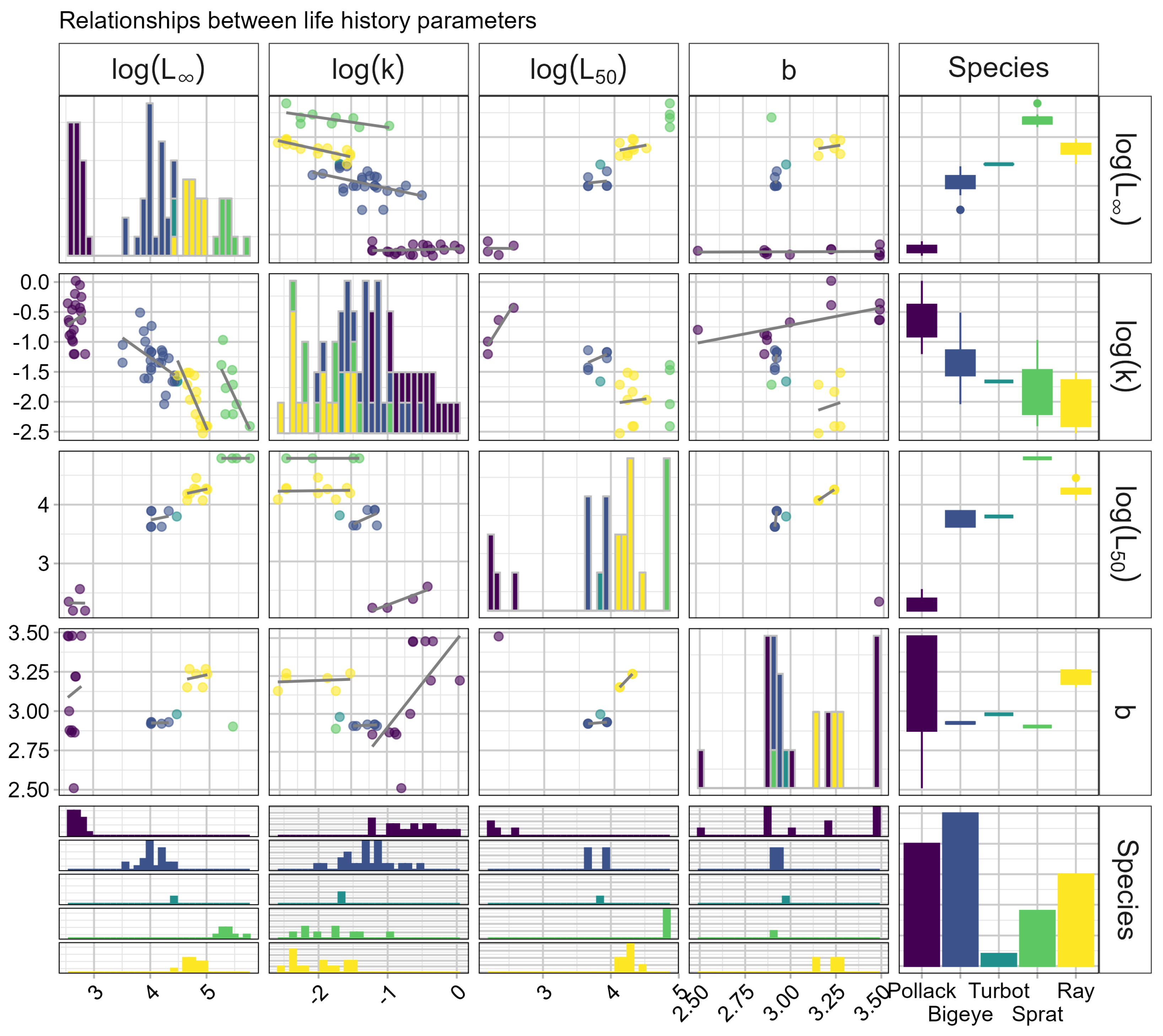


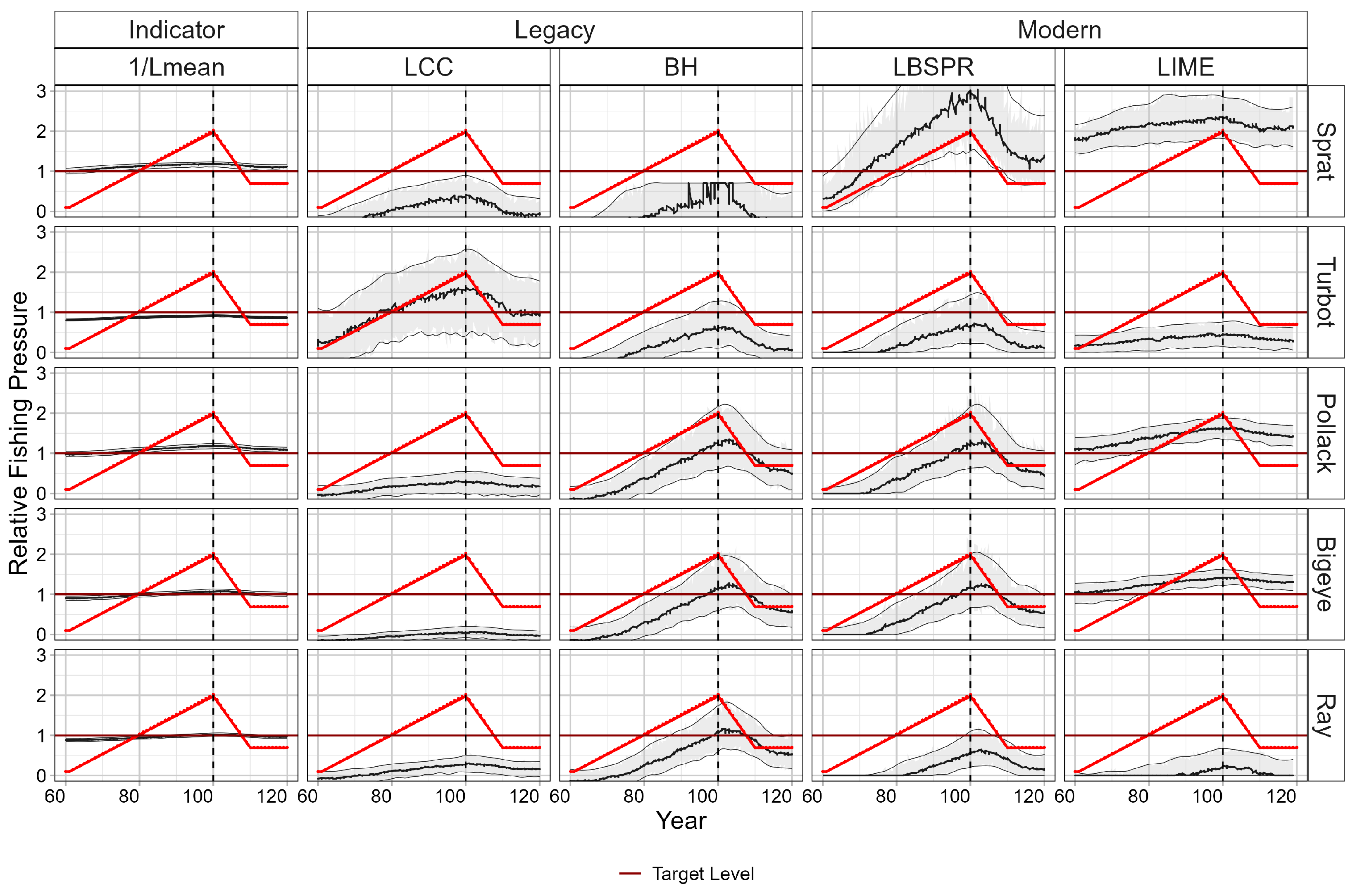
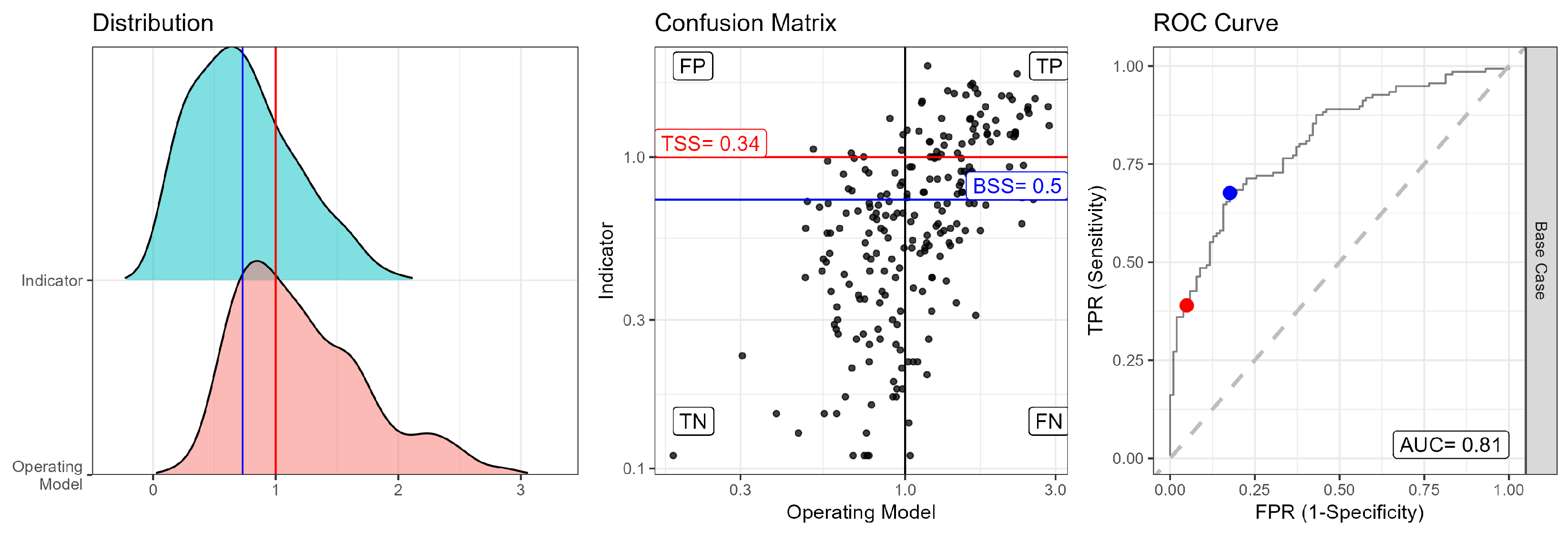
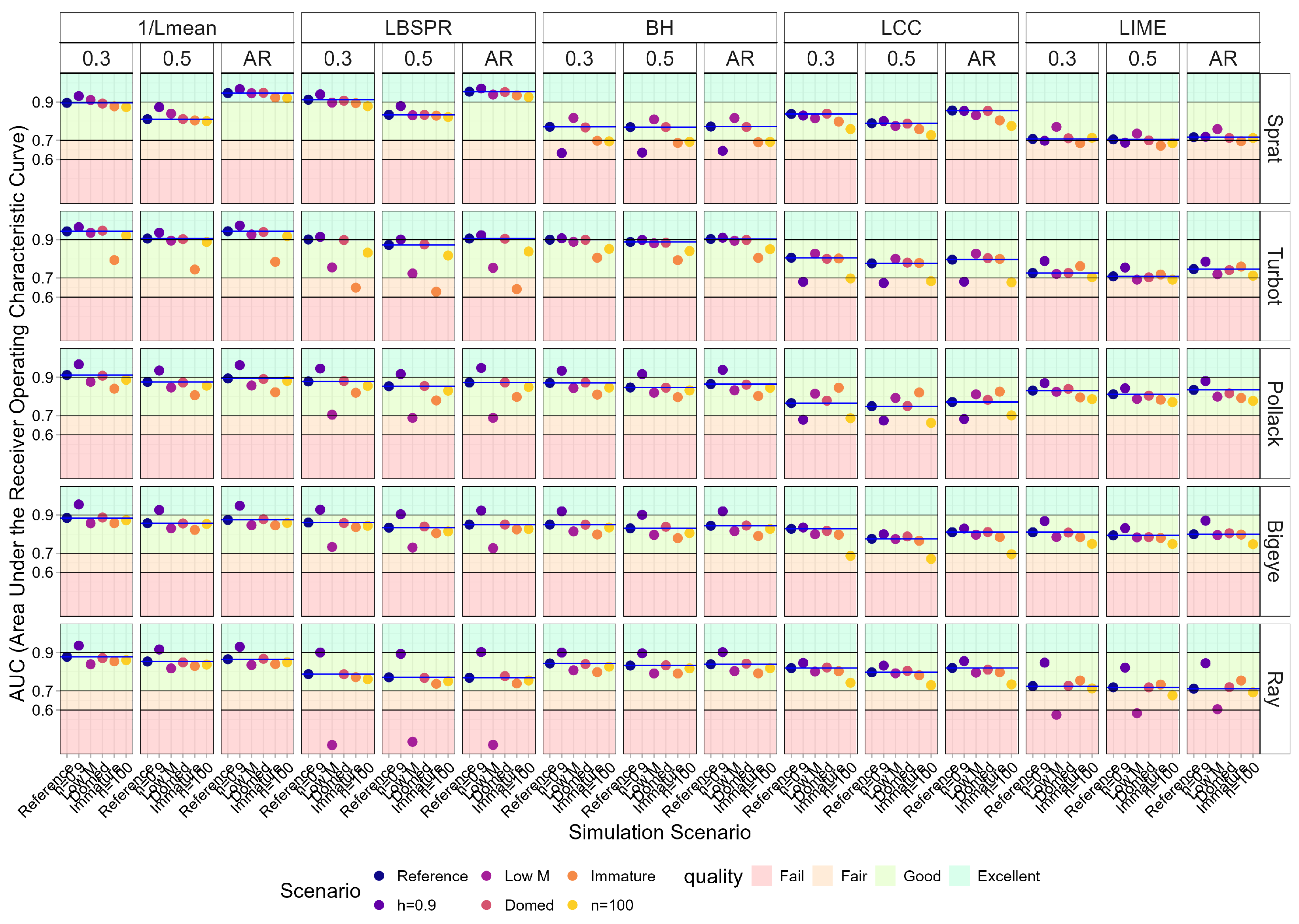

| Category | Parameter | BH | LCC | LBSPR | LIME | ||
|---|---|---|---|---|---|---|---|
| Growth | ✔ | - | ✔ | ✔ | ✔ | ✔ | |
| k | - | - | ✔ | ✔ | ✔ | ✔ | |
| - | - | - | - | - | ✔ | ||
| - | - | - | - | ✔ | - | ||
| - | - | - | - | - | ✔ | ||
| Mortality (M) | Mean | - | - | - | - | ✔ | ✔ |
| Exponent | - | - | - | - | ✔ | - | |
| Maturity | - | - | - | - | - | ✔ | |
| Selectivity | - | - | - | - | ✔ | ✔ | |
| - | - | - | - | ✔ | ✔ | ||
| Shape | - | - | - | - | Logistic | ✔ |
| Parameter | Values |
|---|---|
| Steepness (H) | 0.7 (Reference Case), 0.8, 0.9 |
| Recruitment Variability | Low, Medium, High |
| Natural Mortality (M) | 0.2, 0.25, 0.3 |
| Selectivity | Shifted, Logistic, Domed |
| Sample Size | 50, 100, 150 |
| AUC Categories | |
|---|---|
| Quality | Range |
| Fail | |
| Fair | |
| Good | |
| Excellent | |
| TSS Categories | |
| Quality | Range |
| Negative | |
| None | |
| Low | |
| Moderate | |
| High | |
Disclaimer/Publisher’s Note: The statements, opinions and data contained in all publications are solely those of the individual author(s) and contributor(s) and not of MDPI and/or the editor(s). MDPI and/or the editor(s) disclaim responsibility for any injury to people or property resulting from any ideas, methods, instructions or products referred to in the content. |
© 2025 by the authors. Licensee MDPI, Basel, Switzerland. This article is an open access article distributed under the terms and conditions of the Creative Commons Attribution (CC BY) license (https://creativecommons.org/licenses/by/4.0/).
Share and Cite
Kell, L.T.; Sharma, R. An Evaluation of the Robustness of Length-Based Stock Assessment Approaches for Sustainable Fisheries Management in Data and Capacity Limited Situations. Sustainability 2025, 17, 4791. https://doi.org/10.3390/su17114791
Kell LT, Sharma R. An Evaluation of the Robustness of Length-Based Stock Assessment Approaches for Sustainable Fisheries Management in Data and Capacity Limited Situations. Sustainability. 2025; 17(11):4791. https://doi.org/10.3390/su17114791
Chicago/Turabian StyleKell, Laurence T., and Rishi Sharma. 2025. "An Evaluation of the Robustness of Length-Based Stock Assessment Approaches for Sustainable Fisheries Management in Data and Capacity Limited Situations" Sustainability 17, no. 11: 4791. https://doi.org/10.3390/su17114791
APA StyleKell, L. T., & Sharma, R. (2025). An Evaluation of the Robustness of Length-Based Stock Assessment Approaches for Sustainable Fisheries Management in Data and Capacity Limited Situations. Sustainability, 17(11), 4791. https://doi.org/10.3390/su17114791






